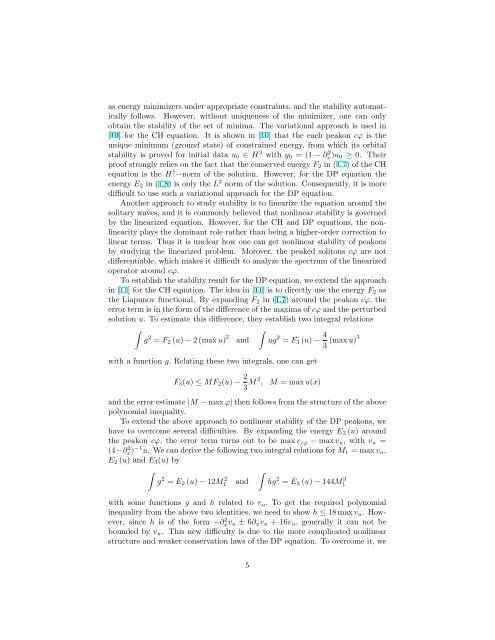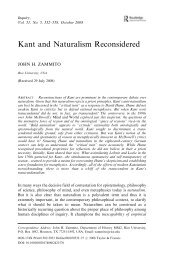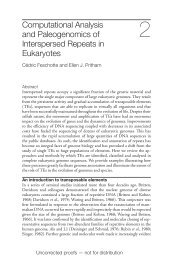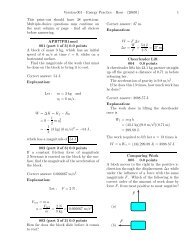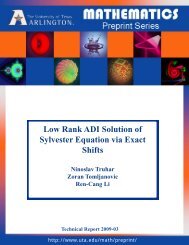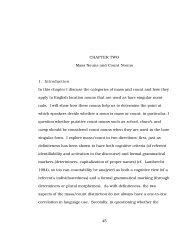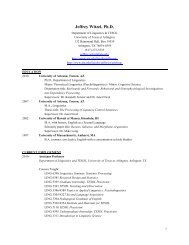Stability of Peakons for the Degasperis-Procesi Equation
Stability of Peakons for the Degasperis-Procesi Equation
Stability of Peakons for the Degasperis-Procesi Equation
Create successful ePaper yourself
Turn your PDF publications into a flip-book with our unique Google optimized e-Paper software.
as energy minimizers under appropriate constraints, and <strong>the</strong> stability automatically<br />
follows. However, without uniqueness <strong>of</strong> <strong>the</strong> minimizer, one can only<br />
obtain <strong>the</strong> stability <strong>of</strong> <strong>the</strong> set <strong>of</strong> minima. The variational approach is used in<br />
[10] <strong>for</strong> <strong>the</strong> CH equation. It is shown in [10] that <strong>the</strong> each peakon cϕ is <strong>the</strong><br />
unique minimum (ground state) <strong>of</strong> constrained energy, from which its orbital<br />
stability is proved <strong>for</strong> initial data u 0 ∈ H 3 with y 0 = (1 − ∂x)u 2 0 ≥ 0. Their<br />
pro<strong>of</strong> strongly relies on <strong>the</strong> fact that <strong>the</strong> conserved energy F 2 in (1.7) <strong>of</strong> <strong>the</strong> CH<br />
equation is <strong>the</strong> H 1 −norm <strong>of</strong> <strong>the</strong> solution. However, <strong>for</strong> <strong>the</strong> DP equation <strong>the</strong><br />
energy E 2 in (1.8) is only <strong>the</strong> L 2 norm <strong>of</strong> <strong>the</strong> solution. Consequently, it is more<br />
difficult to use such a variational approach <strong>for</strong> <strong>the</strong> DP equation.<br />
Ano<strong>the</strong>r approach to study stability is to linearize <strong>the</strong> equation around <strong>the</strong><br />
solitary waves, and it is commonly believed that nonlinear stability is governed<br />
by <strong>the</strong> linearized equation. However, <strong>for</strong> <strong>the</strong> CH and DP equations, <strong>the</strong> nonlinearity<br />
plays <strong>the</strong> dominant role ra<strong>the</strong>r than being a higher-order correction to<br />
linear terms. Thus it is unclear how one can get nonlinear stability <strong>of</strong> peakons<br />
by studying <strong>the</strong> linearized problem. Morover, <strong>the</strong> peaked solitons cϕ are not<br />
differentiable, which makes it difficult to analyze <strong>the</strong> spectrum <strong>of</strong> <strong>the</strong> linearized<br />
operator around cϕ.<br />
To establish <strong>the</strong> stability result <strong>for</strong> <strong>the</strong> DP equation, we extend <strong>the</strong> approach<br />
in [11] <strong>for</strong> <strong>the</strong> CH equation. The idea in [11] is to directly use <strong>the</strong> energy F 2 as<br />
<strong>the</strong> Liapunov functional. By expanding F 2 in (1.7) around <strong>the</strong> peakon cϕ, <strong>the</strong><br />
error term is in <strong>the</strong> <strong>for</strong>m <strong>of</strong> <strong>the</strong> difference <strong>of</strong> <strong>the</strong> maxima <strong>of</strong> cϕ and <strong>the</strong> perturbed<br />
solution u. To estimate this difference, <strong>the</strong>y establish two integral relations<br />
∫<br />
∫<br />
g 2 = F 2 (u) − 2 (max u) 2 and ug 2 = F 3 (u) − 4 (max u)3<br />
3<br />
with a function g. Relating <strong>the</strong>se two integrals, one can get<br />
F 3 (u) ≤ MF 2 (u) − 2 3 M 3 ,<br />
M = max u(x)<br />
and <strong>the</strong> error estimate |M − max ϕ| <strong>the</strong>n follows from <strong>the</strong> structure <strong>of</strong> <strong>the</strong> above<br />
polynomial inequality.<br />
To extend <strong>the</strong> above approach to nonlinear stability <strong>of</strong> <strong>the</strong> DP peakons, we<br />
have to overcome several difficulties. By expanding <strong>the</strong> energy E 2 (u) around<br />
<strong>the</strong> peakon cϕ, <strong>the</strong> error term turns out to be max v cϕ − max v u , with v u =<br />
(4−∂x) 2 −1 u. We can derive <strong>the</strong> following two integral relations <strong>for</strong> M 1 = max v u ,<br />
E 2 (u) and E 3 (u) by<br />
∫<br />
∫<br />
g 2 = E 2 (u) − 12M1<br />
2 and hg 2 = E 3 (u) − 144M1<br />
3<br />
with some functions g and h related to v u . To get <strong>the</strong> required polynomial<br />
inequality from <strong>the</strong> above two identities, we need to show h ≤ 18 max v u . However,<br />
since h is <strong>of</strong> <strong>the</strong> <strong>for</strong>m −∂ 2 xv u ± 6∂ x v u + 16v u , generally it can not be<br />
bounded by v u . This new difficulty is due to <strong>the</strong> more complicated nonlinear<br />
structure and weaker conservation laws <strong>of</strong> <strong>the</strong> DP equation. To overcome it, we<br />
5


